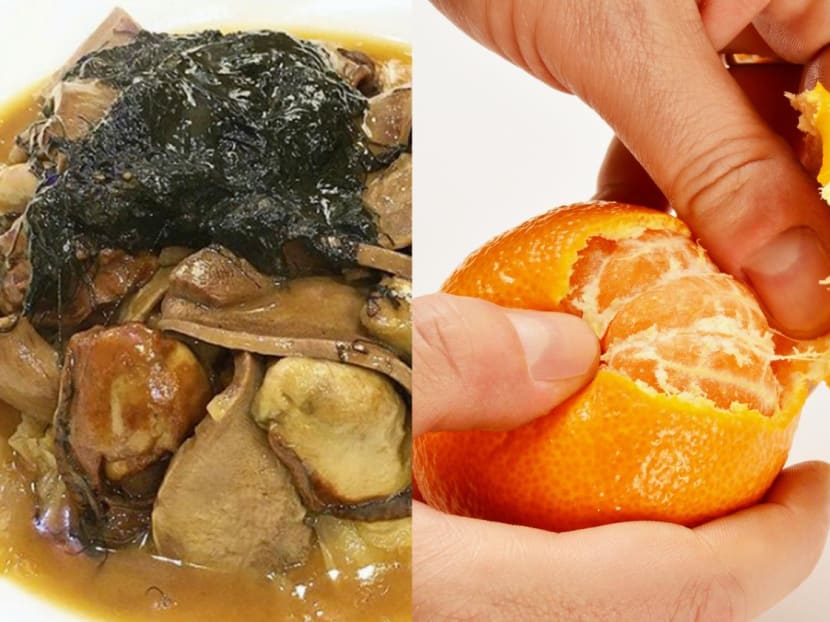A weird thing could happen in your stomach after eating lots of black moss and mandarin oranges
An expert with Singapore General Hospital and National Cancer Centre Singapore shares why he sees patients with stomach problems around Chinese New Year. Hint: It's all that high-fibre food, such as black moss.

(Photos: Instagram/hongkongeatz and iStock/s-cphoto)
Some foods are ubiquitous during Chinese New Year (CNY) because of their appearance (like how mandarin oranges look like golden orbs) or their names are auspicious homonyms.
For instance, having a name like “fatt choy”, which sounds like wishing one prosperity in Cantonese, is a reason why black moss is a popular ingredient in dishes such as pen cai and braised vegetables during this time.
But here’s the thing: These festive treats are also high in fibre and thus, more difficult to digest, according to Assistant Professor Johnny Ong, a consultant with the Department of Sarcoma, Peritoneal and Rare Tumours (SPRinT) in the Division of Surgery and Surgical Oncology at Singapore General Hospital (SGH) and National Cancer Centre Singapore.
What happens is the undigested plant material such as fibre, skin and seeds becomes a trapped mass in the stomach or intestines known as a phytobezoar, he said.
A phyto-what? Perhaps you can think of it as sort of like the human version of a cat’s hairball. Except you can’t cough it up.
What is interesting is that Asst Prof Ong has noted a particular rise in phytobezoars during the CNY period.
In his study on 60 such patients between 1996 and 2018, he found that 20 per cent of the cases occurred within the immediate two weeks before and after CNY.
Although phytobezoars are rare occurrences – Asst Prof Ong consistently sees about three to five cases every year for the past 10 years at SGH – highlighting them can help doctors make better diagnosis such as ruling out colorectal cancer.
“Despite the low incidence, it is an important differential for the clinical team to consider,” he said.
WHY YOU SHOULD CHEW YOUR FOOD WELL
The chewing or mastication of high-fibre food such as fruit and vegetables is vital in ensuring that the food is broken down and prepared for digestion.
This is why older people and those with dental issues who can’t chew properly (regardless of age) are at high risk of developing phytobezoars, particularly if they consume a high-fibre diet such as large portions of mandarin oranges, said Asst Prof Ong.
“Many elderly patients view eating whole mushrooms as a sign of prosperity at CNY reunion dinners,” he said.
“The public should be reminded that despite the low incidence, simple measures such as chewing well or cutting food into smaller pieces can prevent the formation of phytobezoars and intestinal obstruction.”

Age and dental issues aside, you may also be more prone to developing phytobezoars if you’ve had gastric surgery or are suffering from chronic gastritis, Crohn’s disease, gastrointestinal carcinoma, dehydration, hypothyroidism, diabetes, neuropathy, or myotonic dystrophy, he said.
SIGNS YOU MAY HAVE A PHYTOBEZOAR
The last thing you want over the CNY period is a swollen abdomen, stomachache and difficulty passing gas and motion – which is exactly what you’ll feel if you have a clump of undigested fibre blocking your stomach or intestines.
You may also feel full after eating very little food, a lack of appetite, nausea or vomiting.
And it may not take long for a clump to develop. “The time it takes to develop a phytobezoar varies but patients typically present with symptoms a few days after the ingestion of a high-fibre diet,” said Asst Prof Ong.
These indigestible lumps aren’t to be trifled with. “Phytobezoars can lead to intestinal obstruction and perforation of the bowel. If the intestinal obstruction is not relieved, the patient can potentially vomit and aspirate, leading to aspiration pneumonia,” said Asst Prof Ong.

He added: “If left untreated, phytobezoars can induce serious inflammatory changes, leading to ulcer formation, perforation, and misdiagnosis of tumour”.
TREATMENT
If the phytobezoar is found in the stomach, endoscopy may be used to remove it. Sometimes, enzymes, forceps, jet sprays or laser may also be used to fragment the phytobezoar.
However, these methods may not be useful if the lump is located in the small intestine, said Asst Prof Ong, in which case, surgery is usually performed.
“Surgery will usually be performed with or without advanced imaging (eg CT scan) and a mass is usually felt in the small bowel by the surgeon.
"This mass is usually mobile and can be fractured and milked to the colon to relieve the obstruction caused by the phytobezoar,” he said.





